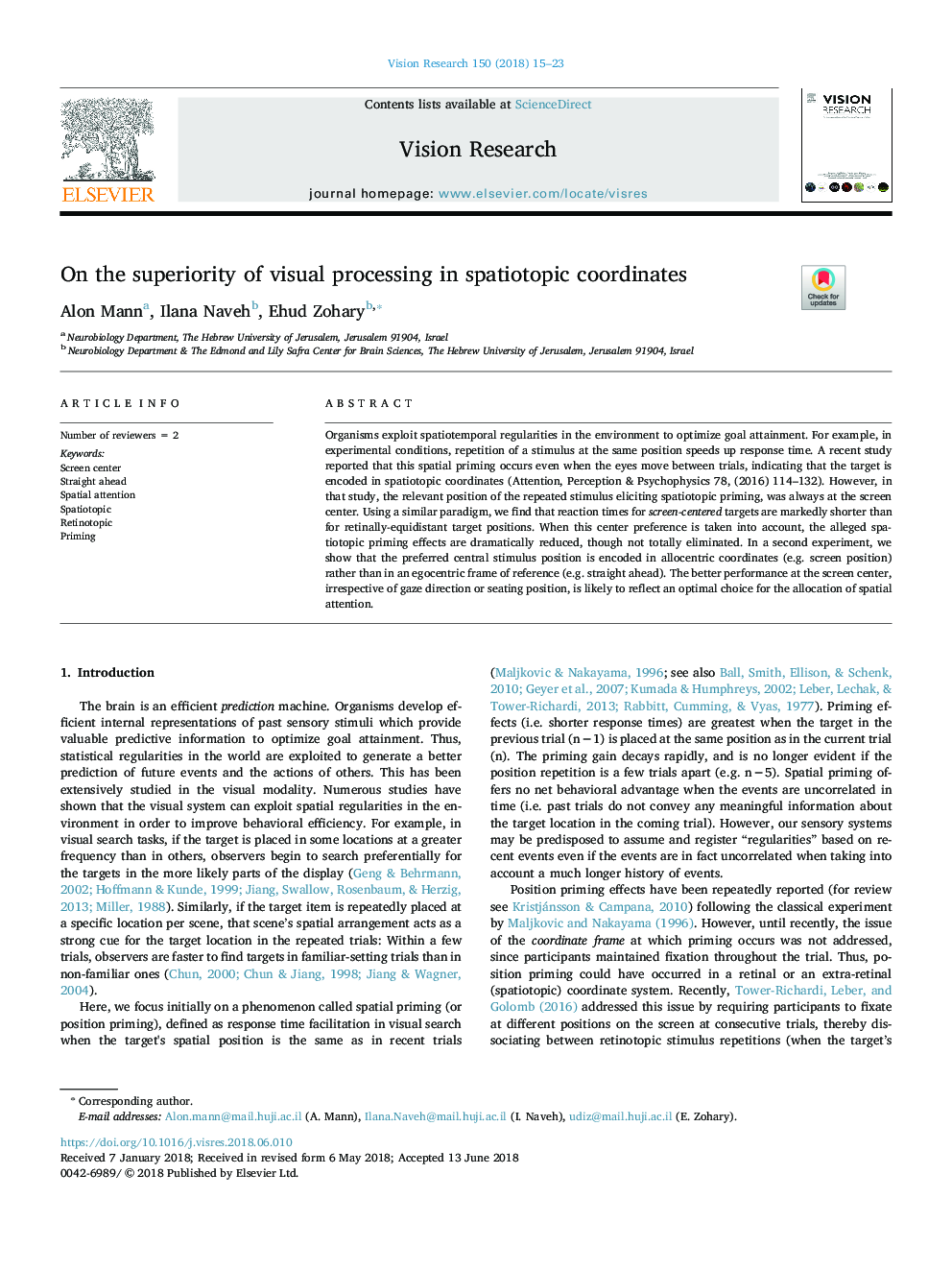| کد مقاله | کد نشریه | سال انتشار | مقاله انگلیسی | نسخه تمام متن |
|---|---|---|---|---|
| 8795273 | 1603150 | 2018 | 9 صفحه PDF | دانلود رایگان |
عنوان انگلیسی مقاله ISI
On the superiority of visual processing in spatiotopic coordinates
ترجمه فارسی عنوان
برتری پردازش تصویر در مختصات فضایی
دانلود مقاله + سفارش ترجمه
دانلود مقاله ISI انگلیسی
رایگان برای ایرانیان
ترجمه چکیده
ارگانیزم ها به منظور بهینه سازی دستیابی به اهداف هدف، قوانین فضایی را در محیط مورد استفاده قرار می دهند. به عنوان مثال، در شرایط آزمایشی، تکرار یک محرک در یک موقعیت، زمان پاسخ را سرعت می دهد. یک مطالعه اخیر نشان داده است که این پرایمر فضایی حتی زمانی اتفاق می افتد که بین آزمایش ها بین حرکت بینجامد، نشان می دهد که هدف در مختصات فضایی (توجه، درک و روان شناسی 78، 2016) 114-132 کدگذاری شده است. با این حال، در این مطالعه، موقعیت مربوط به محرک های مکرر پرایمر اسپاتیوتوپی، همیشه در مرکز صفحه قرار داشت. با استفاده از یک پارادایم مشابه، ما متوجه می شویم که زمان واکنش برای اهداف روی صفحه نمایش به طور چشمگیری کوتاه تر از موقعیت های هدف دقیق شبکیه چشم است. هنگامی که این اولویت مرکز مورد توجه قرار گیرد، اثرات پارتیشن بندی اسپاتیوتوپی به طور چشمگیری کاهش می یابد، اما به طور کامل حذف نمی شود. در آزمایش دوم ما نشان می دهیم که موقعیت محرک مرکزی ترجیح داده شده در مختصات اختصاصی (به عنوان مثال موقعیت مکانی) به جای یک کادر مرجع نفس گیر (به عنوان مثال، مستقیم) کدگذاری می شود. عملکرد بهتر در مرکز صفحه، صرف نظر از جهت دید و موقعیت صندلی، احتمالا منعکس کننده انتخاب مطلوب برای تخصیص توجه فضایی است.
موضوعات مرتبط
علوم زیستی و بیوفناوری
علم عصب شناسی
سیستم های حسی
چکیده انگلیسی
Organisms exploit spatiotemporal regularities in the environment to optimize goal attainment. For example, in experimental conditions, repetition of a stimulus at the same position speeds up response time. A recent study reported that this spatial priming occurs even when the eyes move between trials, indicating that the target is encoded in spatiotopic coordinates (Attention, Perception & Psychophysics 78, (2016) 114-132). However, in that study, the relevant position of the repeated stimulus eliciting spatiotopic priming, was always at the screen center. Using a similar paradigm, we find that reaction times for screen-centered targets are markedly shorter than for retinally-equidistant target positions. When this center preference is taken into account, the alleged spatiotopic priming effects are dramatically reduced, though not totally eliminated. In a second experiment, we show that the preferred central stimulus position is encoded in allocentric coordinates (e.g. screen position) rather than in an egocentric frame of reference (e.g. straight ahead). The better performance at the screen center, irrespective of gaze direction or seating position, is likely to reflect an optimal choice for the allocation of spatial attention.
ناشر
Database: Elsevier - ScienceDirect (ساینس دایرکت)
Journal: Vision Research - Volume 150, September 2018, Pages 15-23
Journal: Vision Research - Volume 150, September 2018, Pages 15-23
نویسندگان
Alon Mann, Ilana Naveh, Ehud Zohary,
